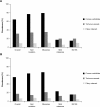Ocular signs correlate well with disease severity and genotype in Fabry disease
- PMID: 25781336
- PMCID: PMC4363518
- DOI: 10.1371/journal.pone.0120814
Ocular signs correlate well with disease severity and genotype in Fabry disease
Abstract
Ocular signs in Fabry disease have generally been regarded to be primarily of diagnostic value. We explored whether ocular findings, alone or in particular in combination with the α-galactosidase A gene mutation, have predictive value for disease severity. Data from the Fabry Outcome Survey (FOS), a large, global database sponsored by Shire, were selected for adult patients who had undergone ophthalmological examination. Three ocular signs were assessed: cornea verticillata, tortuous conjunctival and/or retinal vessels, and cataract. Fabry disease severity was measured using FOS Mainz Severity Score Index and modifications thereof. Ophthalmological data were available for 1203 (699 female, 504 male) adult patients with eye findings characteristic of Fabry disease in 55.1%. Cornea verticillata had a similar distribution in women (51.1%) and men (50.8%), whereas tortuous vessels and Fabry cataract were somewhat more frequent in men than in women. Patients with cornea verticillata, selected as the principal ocular sign for this study, had more severe disease (median score, 20.0) versus those without ocular signs (11.0; P<0.001). This finding could be confirmed by applying age adjusted severity scores. Moreover, the prevalence of cornea verticillata was significantly higher in patients with null (male, 76.9%; female, 64.5%) and missense (male, 79.2%; female, 67.4%) mutations versus mild missense (male, 17.1%; female, 23.1%) and the p.N215S (male, 15.0%; female, 15.6%) mutations (P<0.01). Our analyses show a correlation between the prevalence of ocular changes in Fabry disease and disease severity. Consequently, information on ocular findings and α-galactosidase A gene mutation may help assess the risk for more severe Fabry disease. These observed findings are of notable clinical importance, as Fabry disease is characterized by high clinical course variability and only weak genotype-phenotype correlation at the individual patient level. Further confirmatory studies are needed.
Conflict of interest statement
Figures





References
-
- Breunig F, Weidemann F, Strotmann J, Knoll A, Wanner C. Clinical benefit of enzyme replacement therapy in Fabry disease. Kidney Int. 2006;69: 1216–1221. - PubMed
-
- Schiffmann R, Kopp JB, Austin HA 3rd, Sabnis S, Moore DF, Weibel T, et al. Enzyme replacement therapy in Fabry disease: a randomized controlled trial. JAMA. 2001;285: 2743–2749. - PubMed
Publication types
MeSH terms
LinkOut - more resources
Full Text Sources
Other Literature Sources
Medical

